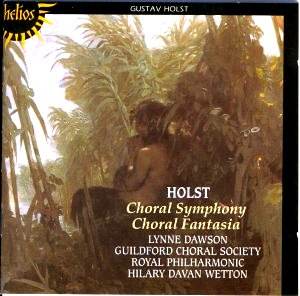Hyperion's policy of ranging back over their dormant
back catalogue and reissuing material at bargain price has surely benefited
both the company and the music enthusiast.
Holst's Choral Fantasia sets Robert Bridges'
'Ode to Music' for soprano solo, chorus, organ and orchestra. The words
must have resonated emotively among the audience at the Gloucester Cathedral
premiere in 1930. Those words include 'Rejoice ye dead, where'er your
spirits dwell / Rejoice that yet on earth your fame is bright.' Whether
or not the composer intended it the words would have spoken with comfort
to generations bereaved by a war that had finished just over a decade
previously. Death is a theme discernible in various Holst works including
Savitri, The Two Veterans Ode (a Whitman setting), The
Ode to Death and, of course, in Saturn from The Planets.
Lynne Dawson's voice is admirably free of vibrato despite an extremely
testing role. This is a work of ice and chill flames as is so often
the case with Holst. In the Ode to Death the music has a warming
consoling undertow. That consolation is subsumed in the Fantasia.
The Choral Symphony sets fulsomely poetic words
by Keats and it is essential that the words are treated with respect
and not fogged by the generalised mist of a big choral group. Here diction
is excellent. The Guildford Choral Society had already proved their
mettle for Lyrita Recorded Edition and Vernon Handley (LP only SRCS75)
in 1975 when they sang another setting of much loved poetry: Finzi's
Ode Intimations of Immortality (Wordsworth). Their diction was
clear and so it continued. Few can match Holst's flyway textures at
tongue-tangling light-speed but the Guildforders trounce the challenge
in 'Ever let the fancy roam'. The Symphony reaches outwards 'Towards
the Unknown Region' far more effectively than Vaughan Williams'
work of that name. In doing so Holst touchingly brushes our cheeks with
music of such otherworldly tenderness that it brings tears to the eye.
Listen to the harp-beat around 'Underneath large blue-bells tented'
(tr 21 3.24 - this is also wonderfully done on the Boult EMI recording)
and to 'Bards of Passion and of Mirth' (tr 21 2.00) which rises to the
dazzling sun. Track 21 is the one to play if you want to sample the
disc. Who else has set with such ineffable beauty the words 'Where the
nightingale doth sing / Not a senseless trancèd thing / But divine
melodious truth'?
You should note that Dorothy Silk was the solo soprano
in the 1925 and 1930 premieres of both the Symphony and the Fantasia.
Competition? The coupling is not unheard of. EMI had
CDC 7 49638 2 (since reissued at midprice) and there was also the Intaglio
CD of a Sargent-conducted Symphony and Boult conducting the Fantasia.
The Intaglio is valuable for its preservation of 1964 and 1967 BBC broadcasts.
It is long gone and I was never clear whether this Italian label was
entirely legal. That aside they did issue many valuable radio performances.
If you see it snap it up not least for Heather Harper's solo contribution
(plummier of voice than Dawson and not as poignant as Palmer) in the
Symphony.
The Helios uses the same text as the original 1993
issue (CDA66660) except for an update for the artist profiles. The full
texts are there. Everything is in English only.
One little aside. Surely the violin solo in 'Next thy
Tasso's ardent numbers' was what inspired the viola title track for
Carl Davis's music for the 1979 BBCTV adaptation of the Thomas Hardy
novel 'The Mayor of Casterbridge' - the one with Alan Bates as Michael
Henchard.
The Helios is the only digital recording of both works.
The Boult/Felicity Palmer is in ADD; the Sargent/Harper also. The analogue
origins of these two discs add a soft-focus to the choral contribution.
The Hyperion disc is generously tracked enabling 22
admission points. Ideal for study and for pleasure. The EMI disc has
only five tracks.
The cover uses a detail from Arnold Böcklin's
Pan Among the Rushes. This is the same Böcklin of The
Isle of the Dead fame.
These are much finer interpretations than the cool
press of the 1990s suggested with its infatuation with the fine EMI
recordings dating from 1964 and 1974. The digital recording presents
the multi-layering of the choral singing with satisfying analysis. These
two works intertwine comfort musically expressed and great poetry of
beauty, life and death. Do we any longer need to concern ourselves with
the sentiments that considered Holst and Finzi pretentious and ill-judged
for setting great poetry. These days the potential audience for these
works will probably have encountered the poetry of Keats and Wordsworth
(and certainly of Bridges - desperately unfashionable) for the first
time only because they have heard these works!
Rob Barnett


